 W
WGoggles, or safety glasses, are forms of protective eyewear that usually enclose or protect the area surrounding the eye in order to prevent particulates, water or chemicals from striking the eyes. They are used in chemistry laboratories and in woodworking. They are often used in snow sports as well, and in swimming. Goggles are often worn when using power tools such as drills or chainsaws to prevent flying particles from damaging the eyes. Many types of goggles are available as prescription goggles for those with vision problems.
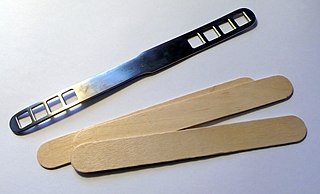 W
WA medical device is any device intended to be used for medical purposes. Medical devices benefit patients by helping health care providers diagnose and treat patients and helping patients overcome sickness or disease, improving their quality of life. Significant potential for hazards are inherent when using a device for medical purposes and thus medical devices must be proved safe and effective with reasonable assurance before regulating governments allow marketing of the device in their country. As a general rule, as the associated risk of the device increases the amount of testing required to establish safety and efficacy also increases. Further, as associated risk increases the potential benefit to the patient must also increase.
 W
WAn acceleromyograph is a piezoelectric myograph, used to measure the force produced by a muscle after it has undergone nerve stimulation. Acceleromyographs may be used, during anaesthesia when muscle relaxants are administered, to measure the depth of neuromuscular blockade and to assess adequacy of recovery from these agents at the end of surgery. Acceleromyography is classified as quantitative neuromuscular monitoring.
 W
WArtificial intelligence in healthcare is an overarching term used to describe the utilization of machine-learning algorithms and software, or artificial intelligence (AI), to emulate human cognition in the analysis, interpretation, and comprehension of complicated medical and healthcare data. Specifically, AI is the ability of computer algorithms to approximate conclusions based solely on input data.
 W
WA cardiac pacemaker, is a medical device that generates electrical impulses delivered by electrodes to cause the heart muscle chambers to contract and therefore pump blood; by doing so this device replaces and/or regulates the function of the electrical conduction system of the heart.
 W
WAn artificial urinary sphincter (AUS) is an implanted device to treat moderate to severe stress urinary incontinence, most commonly in men. The AUS is designed to supplement the function of the natural urinary sphincter that restricts urine flow out of the bladder.
 W
WAshley Black's FasciaBlaster is a self-treatment tool that helps loosen the fascia — the connective tissue around muscles and organs — to ease stiffness and help reduce cellulite. A study was published in 2019 about the effects of fascia manipulation using the FasciaBlaster tools.
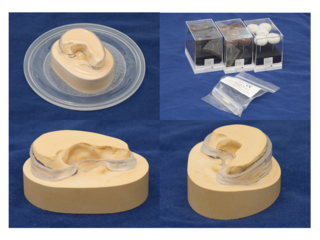 W
WAn auricular splint (AS) or ear splint is a custom-made medical device that is used to maintain auricular projection and dimensions following second stage auricular reconstruction. The AS is made from ethylene-vinyl acetate (EVA), which is typically used to make custom-made mouthguards and was developed by a team from Great Ormond Street Hospital in the United Kingdom.
 W
WA centrifuge is a device that uses centrifugal force to separate various components of a fluid. This is achieved by spinning the fluid at high speed within a container, thereby separating fluids of different densities or liquids from solids. It works by causing denser substances and particles to move outward in the radial direction. At the same time, objects that are less dense are displaced and move to the centre. In a laboratory centrifuge that uses sample tubes, the radial acceleration causes denser particles to settle to the bottom of the tube, while low-density substances rise to the top. A centrifuge can be a very effective filter that separates contaminants from the main body of fluid.
 W
WAnne Rosemary Chamney CEng MIMechE was a mechanical engineer specialising in medical equipment. She is best known for her invention of a novel oxygen tent which was much cheaper than existing tents, it was also lighter and therefore easier to transport. Chamney studied at the Royal Aeronautical Society and became an apprentice at the De Havilland Aircraft Company in Hatfield in 1953. Later she became a senior technician at University College Hospital Medical School where she evaluated hospital equipment. Chamney was awarded the first James Clayton Prize in Medical Engineering from the Institution of Mechanical Engineers.
 W
WA cochlear implant (CI) is a surgically implanted neuroprosthetic device to provide a person with moderate to profound sensorineural hearing loss a modified sense of sound. CI bypasses the normal acoustic hearing process to replace it with electric signals which directly stimulate the auditory nerve. A person with a cochlear implant receiving intensive auditory training may learn to interpret those signals as sound and speech. However, one third of deaf children do not develop language if they are on a CI program alone and have no sign language input.
 W
WA continuous glucose monitor (CGM) is a device used for monitoring blood glucose on a continual basis by people with either type I or type II diabetes. A continuous glucose monitor takes a reading on set intervals with a small electrode placed under the skin and held in place by an adhesive. A transmitter attached to the electrode sends data to a separate receiver.
 W
WA coronary stent is a tube-shaped device placed in the coronary arteries that supply blood to the heart, to keep the arteries open in the treatment of coronary heart disease. It is used in a procedure called percutaneous coronary intervention (PCI). Coronary stents are now used in more than 90% of PCI procedures. Stents reduce angina and have been shown to improve survivability and decrease adverse events in an acute myocardial infarction.
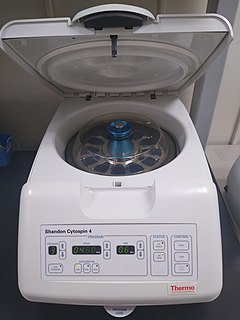 W
WA cytocentrifuge, sometimes referred to as a cytospin, is a specialized centrifuge used to concentrate cells in fluid specimens onto a microscope slide so that they can be stained and examined. Cytocentrifuges are used in various areas of the clinical laboratory, such as cytopathology, hematology and microbiology, as well as in biological research. The method can be used on many different types of specimens, including fine needle aspirates, cerebrospinal fluid, serous and synovial fluid, and urine.
 W
WDeep brain stimulation (DBS) is a neurosurgical procedure involving the placement of a medical device called a neurostimulator, which sends electrical impulses, through implanted electrodes, to specific targets in the brain for the treatment of movement disorders, including Parkinson's disease, essential tremor, and dystonia. While its underlying principles and mechanisms are not fully understood, DBS directly changes brain activity in a controlled manner.
 W
WDefibrillation is a treatment for life-threatening cardiac dysrhythmias, specifically ventricular fibrillation (VF) and non-perfusing ventricular tachycardia (VT). A defibrillator delivers a dose of electric current to the heart. Although not fully understood, this process depolarizes a large amount of the heart muscle, ending the dysrhythmia. Subsequently, the body's natural pacemaker in the sinoatrial node of the heart is able to re-establish normal sinus rhythm. A heart which is in asystole (flatline) cannot be restarted by a defibrillator, but would be treated by cardiopulmonary resuscitation (CPR).
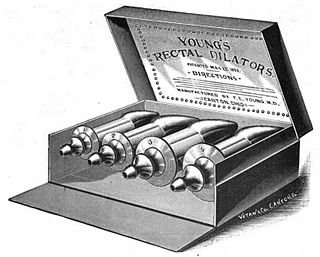 W
WDr. Young's Ideal Rectal Dilators were medical devices sold in the United States from the late nineteenth century until at least the 1940s, part of the burgeoning market for patent and proprietary medicines and devices at the time. They came in sets of four "torpedolike" hard-rubber instruments varying in diameter from 1⁄2 to 1 inch and in length from 3 to 4 inches, and according to a retrospective article in The American Journal of Gastroenterology, were no different from modern rectal dilators.
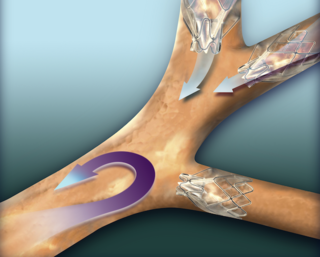 W
WAn endobronchial valve (EBV), is an implantable medical device – a small, one-way valve, which is implanted in an airway in the pulmonary system to treat one of several lung conditions. Endobronchial valves are typically implanted using a flexible delivery catheter advanced through a bronchoscope, and thus they are minimally invasive. The valves are also removable if they are not working properly.
 W
WAn esophageal stent is a stent (tube) placed in the esophagus to keep a blocked area open so the patient can swallow soft food and liquids. Esophageal stents may be self-expandable metallic stents, or made of plastic, or silicone, and may be used in the treatment of esophageal cancer.
 W
WA gastric balloon, also known as stomach balloon, is an inflatable medical device that is temporarily placed into the stomach to reduce weight. It is marketed to provide weight loss when diet and exercise have failed and surgery is not wanted or not recommended.
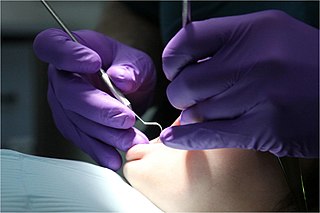 W
WMedical gloves are disposable gloves used during medical examinations and procedures to help prevent cross-contamination between caregivers and patients. Medical gloves are made of different polymers including latex, nitrile rubber, polyvinyl chloride and neoprene; they come unpowdered, or powdered with corn starch to lubricate the gloves, making them easier to put on the hands.
 W
WAn implantable cardioverter-defibrillator (ICD) or automated implantable cardioverter defibrillator (AICD) is a device implantable inside the body, able to perform cardioversion, defibrillation, and pacing of the heart. The device is therefore capable of correcting most life-threatening cardiac arrhythmias. The ICD is the first-line treatment and prophylactic therapy for patients at risk for sudden cardiac death due to ventricular fibrillation and ventricular tachycardia. Current devices can be programmed to detect abnormal heart rhythms and deliver therapy via programmable antitachycardia pacing in addition to low-energy and high-energy shocks.
 W
WThe Ionaco was an electric belt developed by Gaylord Wilshire after his career in politics. It was advertised during the 1920s as a curing device but was dismissed by contemporary medical experts as quackery.
 W
WLeft atrial appendage occlusion (LAAO), also referred to as Left atrial appendage closure (LAAC) is a treatment strategy to reduce the risk of left atrial appendage blood clots from entering the bloodstream and causing a stroke in patients with non-valvular atrial fibrillation (AF).
 W
WThe MERCI Retriever is a medical device designed to treat Ischemic Strokes. The name is an acronym for Mechanical Embolus Removal in Cerebral Ischemia. Designed by University of California, Los Angeles in 2001, MERCI was the first device approved in the U.S. to remove blood clots in patients suffering from acute brain ischemia.
 W
WMitraClip is a medical device used to treat mitral valve regurgitation for individuals who should not have open-heart surgery. It is implanted via a tri-axial transcatheter technique and involves suturing together the anterior and posterior mitral valve leaflets.
 W
WOneTouch Ultra is a blood glucose monitoring device for people with diabetes and is the foundation product for LifeScan's OneTouch Ultra family of blood glucose monitoring systems.
 W
WA penile implant is an implanted device intended for the treatment of erectile dysfunction, Peyronie's disease, ischemic priapism, deformity and traumatic injury of the penis, and for phalloplasty in men or phalloplasty and metoidioplasty in female-to-male gender reassignment surgery. Although there are many distinct types of implants, most fall into one of two categories: malleable and inflatable.
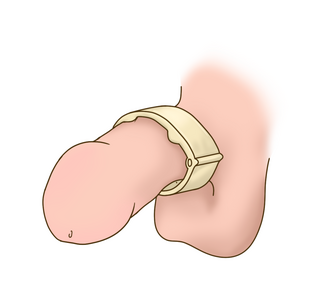 W
WPenis clamp is an external penis compression device that treats male urinary incontinence. Incontinence clamps for men are applied to compress the urethra to compensate for the malfunctioning of the natural urinary sphincter, preventing leakage from the bladder with minimal restriction of blood flow.
 W
WProtected percutaneous coronary intervention, abbreviated as Protected PCI, is a heart procedure that involves a ventricular assist device that is used to treat patients with cardiovascular disease, including advanced heart failure.
 W
WThe Pulsocon of Dr. Gerald Macaura was a device that, according to Macaura, should help women to loosen up and improve their blood circulation.
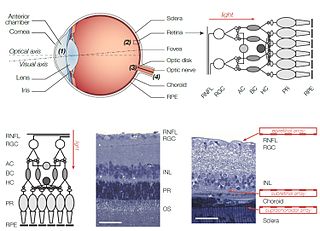 W
WRetinal prostheses for restoration of sight to patients blinded by retinal degeneration are being developed by a number of private companies and research institutions worldwide. The system is meant to partially restore useful vision to people who have lost their photoreceptors due to retinal diseases such as retinitis pigmentosa (RP) or age-related macular degeneration (AMD). Three types of retinal implants are currently in clinical trials: epiretinal, subretinal, and suprachoroidal. Retinal implants introduce visual information into the retina by electrically stimulating the surviving retinal neurons. So far, elicited percepts had rather low resolution, and may be suitable for light perception and recognition of simple objects.
 W
WSingle-use medical devices include any medical equipment, instrument or apparatus having the ability to only be used once in a hospital or clinic and then disposed. The Food and Drug Administration defines this as any device entitled by its manufacturer that it is intended use is for one single patient and one procedure only. It is not reusable, therefore has a short lifespan, and is limited to one patient. There are countless types of single use medical devices, ranging from external, such as plastic gumboots, gloves and bandages merely used to assist a patient to more complex and internal devices, consisting of sharp blades, needles and tubes. Both these devices are single used, because of multiple reasons, but mainly, as it came in contact with radioactivity, blood, infection and disease or human tissue and must therefore be terminated. Each country has its own strict legislation regarding medical waste and the reprocessing of medical devices in hospitals and clinics.
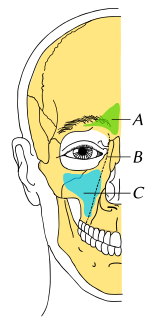 W
WA Sinus implant is a medical device that is inserted into the sinus cavity. Implants can be in conjunction with sinus surgery to treat chronic sinusitis and also in sinus augmentation to increase bone structure for placement of dental implants.
 W
WIn medicine, a stent is a metal or plastic tube inserted into the lumen of an anatomic vessel or duct to keep the passageway open, and stenting is the placement of a stent. There is a wide variety of stents used for different purposes, from expandable coronary, vascular and biliary stents, to simple plastic stents used to allow the flow of urine between kidney and bladder. "Stent" is also used as a verb to describe the placement of such a device, particularly when a disease such as atherosclerosis has pathologically narrowed a structure such as an artery.
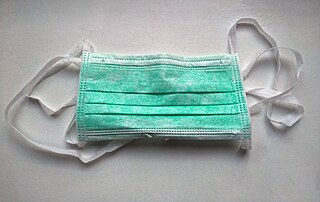 W
WA surgical mask, also known as a medical face mask, is intended to be worn by health professionals during healthcare procedures. Surgical masks are intended to prevent infections in patients and treating personnel by catching bacteria shed in liquid droplets and aerosols from the wearer's mouth and nose. They are not designed to protect the wearer from breathing in airborne bacteria or viruses whose particles are smaller, but could be protective because viruses on droplets are filtered-out. There is a predominance of evidence that surgical masks protect both the wearer and persons near the wearer from the spreading of viruses.
 W
WSurgical mesh is a loosely woven sheet which is used as either a permanent or temporary support for organs and other tissues during surgery. Surgical mesh is created from both inorganic and biological materials and is used in a variety of surgeries. Though hernia repair surgery is the most common application, it can also be used for reconstructive work, such as in pelvic organ prolapse.
 W
WTranscranial direct current stimulation (tDCS) is a form of neuromodulation that uses constant, low direct current delivered via electrodes on the head. It was originally developed to help patients with brain injuries or psychiatric conditions like major depressive disorder. It can be contrasted with cranial electrotherapy stimulation, which generally uses alternating current the same way.
 W
WTranscranial magnetic stimulation (TMS), also known as repetitive transcranial magnetic stimulation (rTMS), is a noninvasive form of brain stimulation in which a changing magnetic field is used to cause electric current at a specific area of the brain through electromagnetic induction. An electric pulse generator, or stimulator, is connected to a magnetic coil, which in turn is connected to the scalp. The stimulator generates a changing electric current within the coil which induces a magnetic field; this field then causes a second inductance of inverted electric charge within the brain itself.
 W
WA vaginal syringe was an object used in the 19th century in the Western world for douching, treating diseases and for birth control. Vaginal syringes were fairly common at the time, but were not openly discussed because of taboos about discussing feminine hygiene. Vaginal syringes were most often made of metal, glass or Bakelite.
 W
WVeinoplus is a class IIa medical device with CE marking. It is indicated for the treatment of vascular diseases. This is a neuromuscular stimulator developed by an American scientist, Jozef Cywinski.
 W
WA ventricular assist device (VAD) is an electromechanical device for assisting cardiac circulation, which is used either to partially or to completely replace the function of a failing heart. The function of VADs is different from that of artificial cardiac pacemakers; some are for short-term use, typically for patients recovering from myocardial infarction and for patients recovering from cardiac surgery; some are for long-term use, typically for patients suffering from advanced heart failure.
 W
WA Zetatron is a high-voltage vacuum tube device that generates a stream of neutrons. The stream can be continuous, or rapidly pulsed on and off. It was invented by Sandia National Laboratories, and is manufactured and marketed by the Thermo Electron Corporation. Applications include research, explosives detection, well logging and body fat analysis.